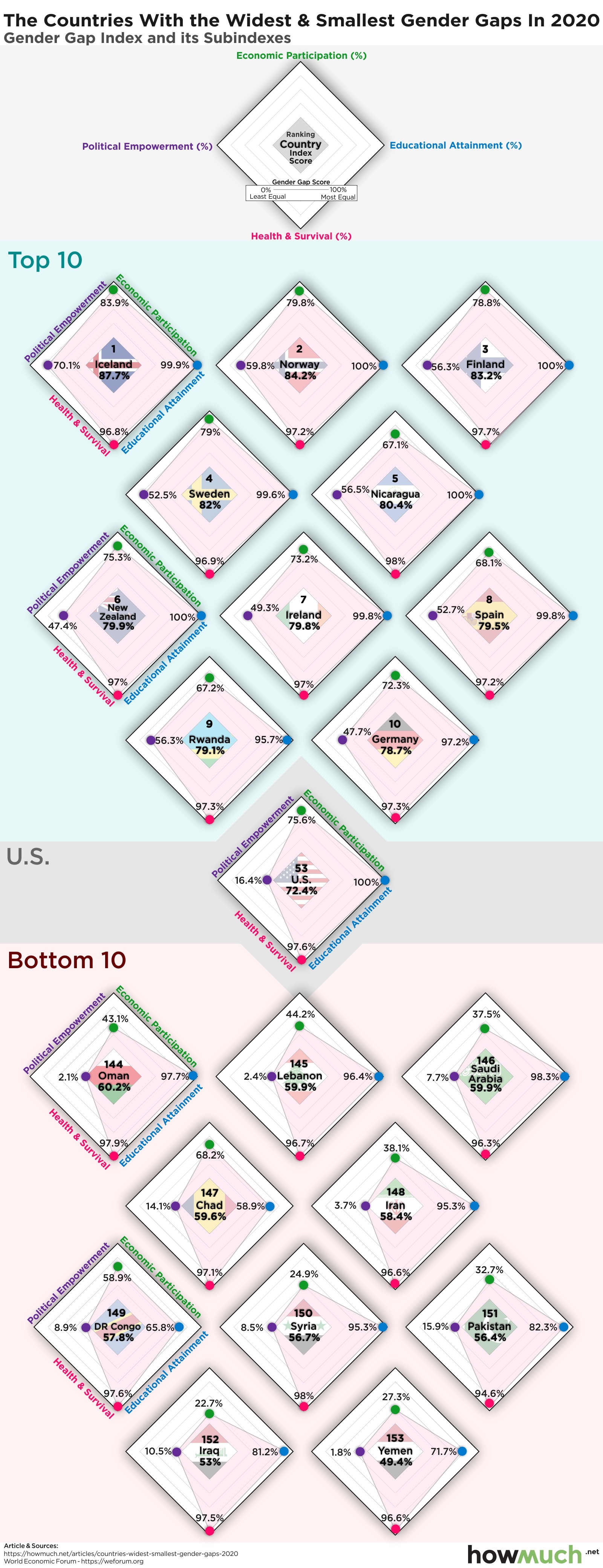As we turn to the next decade, many countries aim to tackle the gender gap inherent in their societies. Exhibited through unequal access to opportunity, academics categorize its causes into structural and merit-based. Some countries continue to make significant strides to improve the situation, while others still need more work. Solutions exist both within the corporate and political spheres to address the problem. Addressing the problem isn’t simply moralistic, it provides economic and social benefits as well.

- 35 countries scored perfect in education, none in economic participation, several scored ~98% in Health, while the highest political involvement score came in at 70.1% followed by a drop to 59.8%
- The average (population-weighted) distance to parity is at 68.6%, which is up from the prior measure.
- Political empowerment remains the largest gap, with 108 of the 149 countries improving year over year.
- Educational opportunity gaps are fairly small across the board, but still have some countries with areas for improvement.
- Using current forecasts, the overall gender gap will close in 99.5 years across 107 countries.
Most Americans know of the fight for gender equality starting with the suffrage movement and extending to the cultural revolution in the ‘60s. Today, America’s Women’s World Cup marked a high achievement in the fight to close the gender gap. Yet, the work begun still has a long way to go, with different distances based on the country.
To draw a comprehensive look at the global gender gap, our visualization looks across 4 categories: Economic Participation, Educational Attainment, Health & Survival, and Political Empowerment. Countries included must have a minimum of 12 out of the 14 indicators that the index measures.
Top 5 Countries with the Smallest Gender Gap
1. Iceland - 87.7%
2. Norway -84.2%
3. Finland - 83.2%
4. Sweden - 82%
5. Nicaragua - 80.4%
Top 5 Countries with the Widest Gender Gap
1. Yemen - 49.4%
2. Iraq - 53%
3. Pakistan - 56.4%
4. Syria - 56.7%
5. Congo, Dem. Rep. - 57.8%
Political movements across the globe work to varying degrees to enhance opportunity and access for females. While education has come the furthest, even in the U.S. there remains legacy biases to overcome.
Luckily, we’re seeing more champions step into the fold across the spectrum. Well-known individuals such as Melinda Gates spearheaded the ‘Equality Can’t Wait’ campaign to focus on gender pay gap issues. And even in the far reaches of the globe, gender equality is finding champions. Malala Yousafzai’s story is one of the most daring and inspiring out there.
It’s important to understand where each country stands relative to one another, and against itself. The information gathered by World Economic Forum helps leaders and advocates in each country understand their progress and shape their decisions.
Although great progress has been achieved, it still would take nearly a century to close the gender pay gap. Governments and corporate citizens along with Non-Governmental Organizations work tirelessly to improve the situation.
But are there efforts effective, or have they missed key components for success?
Data: Table 1.1
About the article
Authors
Irena - Editor





